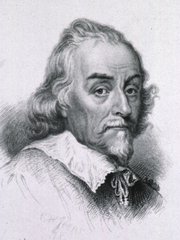This article is part of the series "A Moment in History" where we honor those who have contributed to the growth of medical knowledge in the areas of anatomy, medicine, surgery, and medical research.

William Harvey
William Harvey (1578 - 1609) English physician, physiologist, and anatomist. He was born in Folklestone, where his father was the mayor.
Harvey studied at the King’s College in Canterbury, after which he entered Cambridge. He later traveled through France and Italy and continued his studies in Padua, where he graduated with an MD in 1602. He later returned to Cambridge to complete his Doctoral studies.
He became the Physician-In-Charge at St. Bartholomew’s Hospital. It was at this time that he started a long process of scientific observation and logical reasoning that led him to postulate the circulation of the blood in his 1628 publication "Excercitatio Anatomica de Motu Cordis et Sanguinis in Animalibus" (Anatomical Exercises on the Movement of the Heart and the Blood in Animals).
Harvey’s publication caused incredible controversy, as his proposed theory went against Galen’s theories and the idea that blood passed through "invisible pores" from the right to the left atrium of the heart. His main problem was that he could not prove the presence of capillaries, which were not observed until Antoine van Leeuwenhoek invented the microscope in the late 1600's.
In his book Harvey states ''It is absolutely necessary to conclude that the blood in the animal body is impelled as in a circle and is in a state of ceaseless motion: that this is the act or function which the heart performs by means of the pulse, and that it is the sole and only end of the motion and contraction of the heart”. Even today there are many that use the term “circulatory system” without realizing that the meaning “as in a circle” coined by William Harvey is present in it.
Although the first to consider the term “circulation” was Michael Servetus (1511 – 1553), his ideas were not completely evolved. Had he completed his research and studies Servetus could have precluded Harvey, but he was considered a heretic and burnt at the stake. Thankfully, Harvey was not!
Sources:
1. "William Harvey"Billimoria, A. J Assoc Phys 60 (2012) 57
2. “William Harvey” Foucar, HO. Can Med Assoc J 1951; 64(5): 452–453.
3. “William Harvey” McKecnie, EDJ, Robertson, C. Resuscitation 55 (2002) 133-136
4. “William Harvey, an Aristotelian anatomist” Fara, P. Endeavour 21:2 (2007) 43–44
5. “The life and work of William Harvey” Keele, KD Endeavour 2:3 (1978) 104–107
Original image in the Public Domain. Courtesy of the National Library of Medicine



